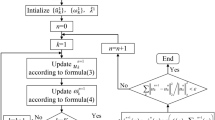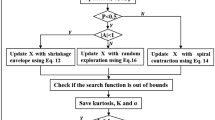Abstract
Due to the poor rigidity of thin-walled parts, vibration (chatter) is extremely easy to occur during the cutting process, affecting the precision, surface quality, and efficiency of part processing. The chatter in milling thin-walled workpieces becomes a more complex, nonlinear, and unstable signal as the dynamics of thin-walled workpieces change with time and position. To realize chatter detection, a method using ensemble empirical mode decomposition (EEMD) and nonlinear dimensionless indicators is proposed in this paper. Firstly, the EEMD is adopted to decompose the raw signal because it is suited for nonlinear and nonstationary signal. Subsequently, the correlation analysis is used to obtain chatter-related intrinsic mode function (IMF) components. When chatter occurs in the milling, time series complexity is changed and energy is transferred to the chatter bands. Therefore, the nonlinear sample entropy (SE) and energy entropy (EE) of IMFs can be extracted as two indicators. Then, principal component analysis (PCA) is adopted to further reduce the feature vector dimension. After that, an improved support vector machine (SVM) is developed to identify the chatter. Among them, genetic algorithm (GA) and grid explore (GE) are used to explore the best parameters of the SVM. In addition, off-line chatter prediction is employed to determine the cutting status under different machining parameters used in the experiments. At last, the cutting force signals are performed to verify the proposed method. The results show the proposed method using SE and EE can effectively detect the chatter, which provides an option for chatter detection.













Similar content being viewed by others
Abbreviations
- SE:
-
Sample entropy
- EE:
-
Energy entropy
- EMD:
-
Empirical mode decomposition
- EEMD:
-
Ensemble empirical mode decomposition
- IMF:
-
Intrinsic mode function
- PCA:
-
Principal component analysis
- GA:
-
Genetic algorithm
- GE:
-
Grid explore
- SVM:
-
Support vector machine
- IM:
-
Intelligent manufacturing
- AI:
-
Artificial intelligence
- ANN:
-
Artificial neural network
- SLD:
-
Stability lobe diagram
- KF:
-
Kernel function
- RBKF:
-
Radial basis KF
- R i :
-
Energy of IMFs
- E i :
-
EE of IMFs
- λ1, λ2 :
-
The SE, EE, of n IMFs
- γ :
-
The threshold for selecting the related IMFs
- ρ i :
-
The eigenvalues of principal components
- x(t):
-
The original signal
- ni(t):
-
The ith white noise
- xi(t):
-
The new signal with noise
- xi, xj :
-
The samples or vectors
- σ :
-
The width of KF
- c :
-
Penalty factor
- g :
-
Core parameter
- ri(t):
-
The residual at the ith trial
- x0, x1, x2 :
-
Sinusoidal signals, sinusoidal low frequency, discontinuity high frequency
- x, y :
-
Two directions of machine tool
- Kt, Kr :
-
Tangential cutting force coefficient, radial cutting force coefficient
- x(1), x(2), ⋯, x(N) :
-
A N point time series
- Xm(i):
-
A m dimension vector
- d[Xm(i), Xm(j)]:
-
The distance between Xm(i) and Xm(j)
- r :
-
Tolerance
- A i :
-
The number of d[Xm(i), Xm(j)] ≤ r
- \( {B}_i^m(r),{B}^m(r) \) :
-
The ratio of Ai to N − m + 1, the average of \( {B}_i^m(r) \)
- SampEn(m, r):
-
The theoretical SE of the time series
- SampEn(m, r, N):
-
The estimated value of the SE
- u1(t), u2(t), ⋯un(t):
-
The frequency bands (IMFs)
- T i :
-
The percentage that energy of IMF counts for the whole signal’s energy R
- μ i :
-
Correlation coefficients
- v i :
-
The contribution rate of the ith principal component
- Q :
-
The contribution rate of the previous kth principal components
- m :
-
The number of ensample
- c ij :
-
The jth IMF at the ith trial (EMD)
- c j :
-
The jth IMF by EEMD
- I :
-
The number of IMFs of each trial
References
Altintas Y, Ber A (2001) Manufacturing automation: metal cutting mechanics, machine tool vibrations, and CNC design. Appl Mech Rev 54(5):B84–B84
Graham E, Mehrpouya M, Park S (2013) Robust prediction of chatter stability in milling based on the analytical chatter stability. J Manuf Process 15(4):508–517
Siddhpura M, Paurobally R (2012) A review of chatter vibration research in turning. Int J Mach Tools Manuf 61(1):27–47
Zhang C, Li B, Chen B, Cao H, Zi Y, He Z (2015) Weak fault signature extraction of rotating machinery using flexible analytic wavelet transform. Mech Syst Signal Process 64(1):162–187
Gonzalez-Brambila O, Rubio E, Jáuregui JC, Herrera-Ruiz G (2006) Chattering detection in cylindrical grinding processes using the wavelet transform. Int J Mach Tools Manuf 46(15):1934–1938
Wang C, Zhang X, Liu Y, Cao H, Chen X (2018) Stiffness variation method for milling chatter suppression via piezoelectric stack actuators. Int J Mach Tools Manuf 124(1):53–66
Ding L, Sun Y, Xiong Z (2020) Adaptive removal of time-varying harmonics for chatter detection in thin-walled turning. Int J Adv Manuf Technol 106(1-2):519–531
Liu C, Zhu L, Ni C (2017) The chatter identification in end milling based on combining EMD and WPD. Int J Adv Manuf Technol 91(9-12):3339–3348
Dong X, Zhang W (2017) Chatter identification in milling of the thin-walled part based on complexity index. Int J Adv Manuf Technol 91(9-12):3327–3337
Lamraoui M, Thomas M, El Badaoui M (2014) Cyclostationarity approach for monitoring chatter and tool wear in high speed milling. Mech Syst Signal Process 44(1-2):177–198
Wang Y, Bo Q, Liu H, Hu L, Zhang H (2018) Mirror milling chatter identification using Q-factor and SVM. Int J Adv Manuf Technol 98(5-8):1163–1177
Khasawneh FA, Munch E (2016) Chatter detection in turning using persistent homology. Mech Syst Signal Process 70(1):527–541
Hynynen KM, Ratava J, Lindh T, Rikkonen M, Ryynänen V, Lohtander M, Varis J (2014) Chatter detection in turning processes using coherence of acceleration and audio signals. J Manuf Sci Eng 136(4):5–9
Thaler T, Potočnik P, Bric I, Govekar E (2014) Chatter detection in band sawing based on discriminant analysis of sound features. Appl Acoust 77(1):114–121
Aslan D, Altintas Y (2018) On-line chatter detection in milling using drive motor current commands extracted from CNC. Int J Mach Tools Manuf 132(1):64–80
Luo M, Luo H, Axinte D, Liu D, Mei J, Liao Z (2018) A wireless instrumented milling cutter system with embedded PVDF sensors. Mech Syst Signal Process 110(1):556–568
Axinte DA, Gindy N, Fox K, Unanue I (2004) Process monitoring to assist the workpiece surface quality in machining. Int J Mach Tools Manuf 44(10):1091–1108
Quintana G, Ciurana J (2011) Chatter in machining processes: a review. Int J Mach Tools Manuf 51(5):363–376
Ji Y, Wang X, Liu Z, Yan Z, Jiao L, Wang D, Wang J (2017) EEMD-based online milling chatter detection by fractal dimension and power spectral entropy. Int J Adv Manuf Technol 92(1-4):1185–1200
Chen Y, Li H, Hou L, Wang J, Bu X (2018) An intelligent chatter detection method based on EEMD and feature selection with multi-channel vibration signals. Measurement 127(1):356–365
Cao H, Zhou K, Chen X (2015) Chatter identification in end milling process based on EEMD and nonlinear dimensionless indicators. Int J Mach Tools Manuf 92(1):52–59
Pérez-Canales D, Vela-Martínez L, Jáuregui-Correa JC, Alvarez-Ramirez J (2012) Analysis of the entropy randomness index for machining chatter detection. Int J Mach Tools Manuf 62(1):39–45
Yang K, Wang G, Dong Y, Zhang Q, Sang L (2019) Early chatter identification based on an optimized variational mode decomposition. Mech Syst Signal Process 115(1):238–254
Liu C, Zhu L, Ni C (2018) Chatter detection in milling process based on VMD and energy entropy. Mech Syst Signal Process 105(1):169–182
Caliskan H, Kilic ZM, Altintas Y (2018) On-line energy-based milling chatter detection. J Manuf Sci Eng 140(11):1–7
Liu Y, Wu B, Ma J, Zhang D (2017) Chatter identification of the milling process considering dynamics of the thin-walled workpiece. Int J Adv Manuf Technol 89(5-8):1765–1773
Lamraoui M, Barakat M, Thomas M, Badaoui ME (2015) Chatter detection in milling machines by neural network classification and feature selection. J Vib Control 21(7):1251–1266
Yao Z, Mei D, Chen Z (2010) On-line chatter detection and identification based on wavelet and support vector machine. J Mater Process Technol 210(5):713–719
Peng C, Wang L, Liao TW (2015) A new method for the prediction of chatter stability lobes based on dynamic cutting force simulation model and support vector machine. J Sound Vib 354(1):118–131
Abdoos AA, Mianaei PK, Ghadikolaei MR (2016) Combined VMD-SVM based feature selection method for classification of power quality events. Appl Soft Comput 38(1):637–646
Tuysuz O, Altintas Y (2017) Frequency domain updating of thin-walled workpiece dynamics using reduced order substructuring method in machining. J Manuf Sci Eng 139(7):1–8
Ye J, Feng P, Xu C, Ma Y, Huang S (2018) A novel approach for chatter online monitoring using coefficient of variation in machining process. Int J Adv Manuf Technol 96(1-4):287–297
Gao J, Song Q, Liu Z (2018) Chatter detection and stability region acquisition in thin-walled workpiece milling based on CMWT. Int J Adv Manuf Technol 98(1-4):699–713
Wu Z, Huang NE (2009) Ensemble empirical mode decomposition: a noise-assisted data analysis method. Adv Ada Data Analy 1(01):1–41
Yan B, Zhu L (2019) Research on milling stability of thin-walled parts based on improved multi-frequency solution. Int J Adv Manuf Technol 102(1-4):431–441
Pincus SM (1991) Approximate entropy as a measure of system complexity. Proc Natl Acad Sci 88(6):2297–2301
Richman JS, Moorman JR (2000) Physiological time-series analysis using approximate entropy and sample entropy. Int J Phy CirPhy 278(6):H2039–H2049
Funding
This work was supported by the National Natural Science Foundation of China (51475087) and Fundamental Research Funds for Central Universities (N170306005 and N180305032).
Author information
Authors and Affiliations
Corresponding author
Additional information
Publisher’s note
Springer Nature remains neutral with regard to jurisdictional claims in published maps and institutional affiliations.
Rights and permissions
About this article
Cite this article
Zhu, L., Liu, C., Ju, C. et al. Vibration recognition for peripheral milling thin-walled workpieces using sample entropy and energy entropy. Int J Adv Manuf Technol 108, 3251–3266 (2020). https://doi.org/10.1007/s00170-020-05476-7
Received:
Accepted:
Published:
Issue Date:
DOI: https://doi.org/10.1007/s00170-020-05476-7




